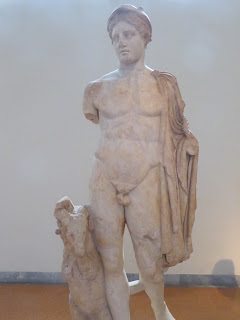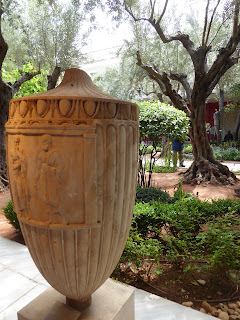I always expected this to be one of the highlights of my visit to Athens. It has a fabulous collection of my favourite things, classical statuary. Why? Well apart from just being aesthetically pleasing its also an art form that later Ancient Greece got down to, well a fine art. Sculpture hasn't really been improved upon in the last 2000 years.
However, after seeing the new Acropolis Museum, I have to say this one looks very tired. Fine neo-classical facade, but the interior has a flimsy 1950s feel.
And I have to express two annoyances that were not well publicised. The first is that although the museum is supposed to close at 8 pm, in fact they closed off some of the upstairs galleries at 3:30pm. I guess to save money on staff but would have been nice if one had been told with a prominent sign somewhere.
More baffling, the museum shop closed at 3:30 too, 4 and a half hours before the museum. Now a the world over, museum shops don't exist to further art, they make a profit to support the museum. But of course Greece is renowned for its wealth and has no need to raise money for any public works...
So, somewhat miffed I had to come back the next day to pick up a guide book as a souvenir of my visit, and to allow me to read about some of the stuff at more leisure. But having had a quick look around I couldn't see the guide to the collection. I enquired and rather sheepishly the shop assistant said they didn't have one. They did have little pamphlets about parts of teh collection, but they only had three of them in English. And yes of course they were the three most obscure sections, because of course they had sold out of the main ones.
Again, museums publish guides to make money. But this being Greece, hey why bother. We have had some old ones so will just wait for them to sell out, and then, hey why go to all the bother of printing something just to make some money or because there is demand? Unsurprisingly, the most empty museum shop I have been to. Still, there were two people employed to stand around watching, and they knock off early afternoon so all is well.
The sculpture collection starts off with the archaic statues, so one can see the development from a very formulaic representation to the fluid realistic one we have come to know. The earlier statues are known as kouroi and the young men all have a slightly stylised physique and a somewhat sickly smile on their faces (or would have if the head wasn't missing).
Then we get a slightly more naturalistic pose and expression.
 |
| Bit of sporting endeavour - wrestling |
 |
| and rather less well-known, an ancient version of hockey. |
 |
| Note the negro heads in these small perfume jugs. It was a cosmopolitan world. |
The great tragedy is that the bronzes are more impressive than the marble copies.
 |
| And football too. A sporting lot. Game of keepy-uppy. |
Another excellent bronze, well rendered body but just look how well the face is portrayed, and especially the eyes.
Sometimes we are only left with bits, but see how well moulded the feet are below.
So there the sculpture galleries finish in the Hellenistic era. That forms a sort of horseshoe configuration in the museum. Down the middle are the Mycenean galleries, so predating the massive sculptures. Here we are looking more at early gold-working, and so over 3000 rather than 2000 years old..
I spent most of the day in the museum, so went to the courtyard restaurant for lunch, itself packed with exhibits.
There is a section devoted to small bronze objects that have survived in greater numbers.
 |
| If you are wondering, this is cheek-flap off an ornate helmet. |
These exquisite bits of jewellery are thought to fit round a bun of hair at the back.
There is small Egyptian collection too.
Upstairs there is a room dedicated to discoveries on Santorini, a sort of Greek Pompeii - hence the survival of frescoes.
But mostly upstairs (or te part that was open) is devoted to Greek pottery. And it is a superb collection.



















































































































































No comments:
Post a Comment